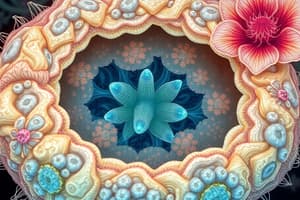Podcast
Questions and Answers
What are the building blocks for living things?
What are the building blocks for living things?
- Tissues
- Atoms
- Molecules
- Cells (correct)
What two kinds of cells are there?
What two kinds of cells are there?
Plant and animal cells
What structure do plant cells have that animal cells do not?
What structure do plant cells have that animal cells do not?
- Ribosomes
- Chloroplasts (correct)
- Nucleus
- Cell membrane
How are plant cells different from animal cells?
How are plant cells different from animal cells?
How are animal and plant cells alike?
How are animal and plant cells alike?
What is the outside layer of animal cells called?
What is the outside layer of animal cells called?
What is a cell?
What is a cell?
What is a cell wall?
What is a cell wall?
What is the function of chloroplasts?
What is the function of chloroplasts?
What is cytoplasm?
What is cytoplasm?
What defines a eukaryote?
What defines a eukaryote?
What are lysosomes?
What are lysosomes?
What is an organelle?
What is an organelle?
What shape are animal cells?
What shape are animal cells?
What shape are plant cells?
What shape are plant cells?
What do centrioles do?
What do centrioles do?
What is the role of ribosomes?
What is the role of ribosomes?
What do chloroplasts capture from sunlight?
What do chloroplasts capture from sunlight?
What does a vacuole do in plant cells?
What does a vacuole do in plant cells?
What forms a barrier in animal cells?
What forms a barrier in animal cells?
What is the non-living material surrounding plant cells called?
What is the non-living material surrounding plant cells called?
Prokaryotic cells have a nucleus.
Prokaryotic cells have a nucleus.
What is true about all prokaryotes?
What is true about all prokaryotes?
What defines a eukaryotic cell?
What defines a eukaryotic cell?
What organisms are classified as eukaryotes?
What organisms are classified as eukaryotes?
Prokaryotes have membrane-bound organelles.
Prokaryotes have membrane-bound organelles.
What do both prokaryotic and eukaryotic cells have?
What do both prokaryotic and eukaryotic cells have?
What genetic material do eukaryotes contain?
What genetic material do eukaryotes contain?
What is a characteristic of eukaryotic cells?
What is a characteristic of eukaryotic cells?
What type of cells include archaea and eubacteria?
What type of cells include archaea and eubacteria?
Eukaryotes have a nucleus.
Eukaryotes have a nucleus.
What DNA structure do prokaryotic cells have?
What DNA structure do prokaryotic cells have?
Prokaryotic cells are the simplest of the two cell types.
Prokaryotic cells are the simplest of the two cell types.
What type of cells includes bacteria?
What type of cells includes bacteria?
What distinguishes eukaryotic cells concerning DNA?
What distinguishes eukaryotic cells concerning DNA?
Flashcards are hidden until you start studying
Study Notes
Cell Basics
- Cells are the fundamental building blocks of all living organisms.
- They contain a nucleus and various organelles.
- Two main types of cells: plant cells and animal cells.
Plant Cells
- Characterized by a rigid cell wall which helps maintain structure.
- Contain chloroplasts, enabling photosynthesis for food production.
- Generally have a square shape and one large vacuole for storage.
Animal Cells
- Surrounded by a flexible cell membrane, lacking a cell wall.
- Capable of movement due to their structure.
- Typically round in shape and contain smaller vacuoles compared to plant cells.
Similarities Between Plant and Animal Cells
- Both types of cells contain a nucleus and organelles, facilitating vital cellular functions.
Cell Structures
- Cell Membrane: Outer layer of animal cells that regulates entry and exit of substances.
- Cell Wall: A sturdy layer found in plant cells, primarily composed of cellulose, providing support and shape.
- Chloroplasts: Organelles in plant cells responsible for photosynthesis, containing chlorophyll.
- Cytoplasm: A gel-like substance between the cell membrane and nucleus where chemical reactions occur.
- Lysosomes: Contain digestive enzymes to break down waste.
- Vacuoles: Storage sacs for food, waste, and water; larger in plant cells than in animal cells.
Cell Types
- Eukaryote: Cells with a nucleus and membrane-bound organelles; includes protists, fungi, plants, and animals.
- Prokaryote: Simple cells without a nucleus or membrane-bound organelles; predominantly unicellular and include bacteria and archaea.
Differences Between Prokaryotic and Eukaryotic Cells
- Prokaryotic cells are simpler, lack a nucleus, and have no membrane-bound organelles.
- Eukaryotic cells are more complex, with a defined nucleus and various organelles allowing specialized functions.
- Both cell types contain ribosomes and genetic material (DNA).
Genetic Material
- Prokaryotes possess a single circular strand of DNA.
- Eukaryotes have multiple straight strands of DNA contained within the nucleus.
Additional Notes
- Eukaryotic cells can be unicellular or multicellular.
- Prokaryotic organisms are the simplest cellular forms, primarily unicellular bacteria.
- Membrane-bound organelles are characteristic of eukaryotic cells, enabling compartmentalization of cellular processes.
Studying That Suits You
Use AI to generate personalized quizzes and flashcards to suit your learning preferences.




